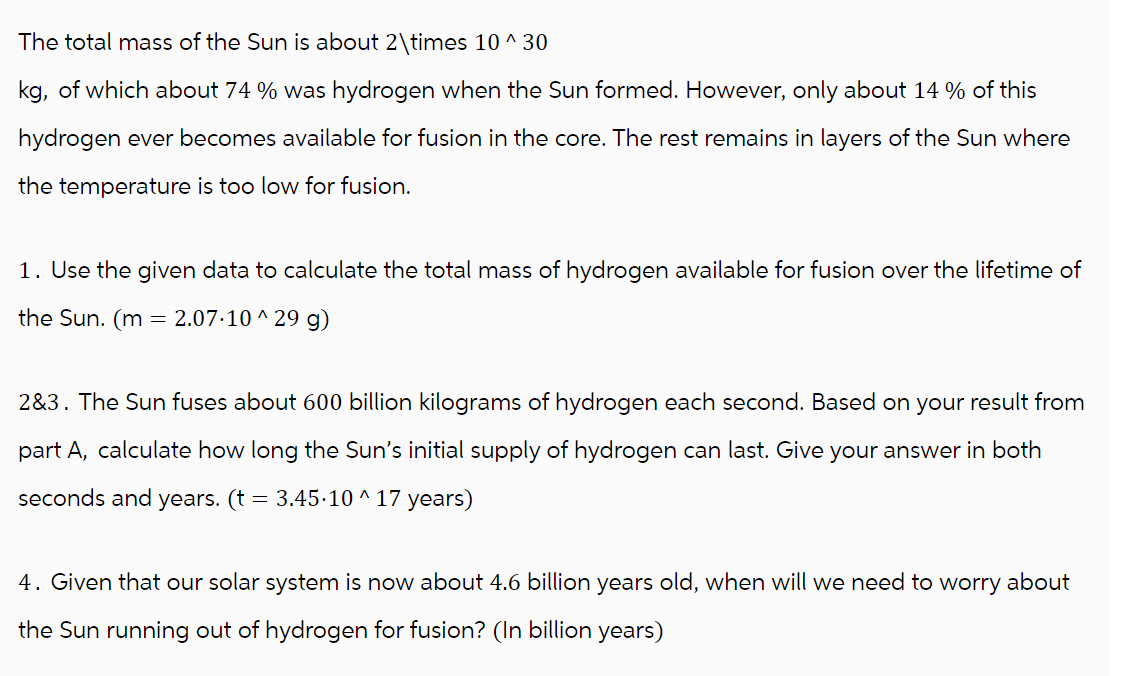The total mass of the Sun is about 2\times 10 ^ 30 kg, of which about 74 % was hydrogen when the Sun formed. However, only about 14% of this hydrogen ever becomes available for fusion in the core. The rest remains in layers of the Sun where the temperature is too low for fusion. 1. Use the given data to calculate the total mass of hydrogen available for fusion over the lifetime of the Sun. (m = 2.07.10^29 g) 2&3. The Sun fuses about 600 billion kilograms of hydrogen each second. Based on your result from part A, calculate how long the Sun's initial supply of hydrogen can last. Give your answer in both seconds and years. (t = 3.45.10^17 years) 4. Given that our solar system is now about 4.6 billion years old, when will we need to worry about the Sun running out of hydrogen for fusion? (In billion years)
The total mass of the Sun is about 2\times 10 ^ 30 kg, of which about 74 % was hydrogen when the Sun formed. However, only about 14% of this hydrogen ever becomes available for fusion in the core. The rest remains in layers of the Sun where the temperature is too low for fusion. 1. Use the given data to calculate the total mass of hydrogen available for fusion over the lifetime of the Sun. (m = 2.07.10^29 g) 2&3. The Sun fuses about 600 billion kilograms of hydrogen each second. Based on your result from part A, calculate how long the Sun's initial supply of hydrogen can last. Give your answer in both seconds and years. (t = 3.45.10^17 years) 4. Given that our solar system is now about 4.6 billion years old, when will we need to worry about the Sun running out of hydrogen for fusion? (In billion years)
Applications and Investigations in Earth Science (9th Edition)
9th Edition
ISBN:9780134746241
Author:Edward J. Tarbuck, Frederick K. Lutgens, Dennis G. Tasa
Publisher:Edward J. Tarbuck, Frederick K. Lutgens, Dennis G. Tasa
Chapter1: The Study Of Minerals
Section: Chapter Questions
Problem 1LR
Related questions
Question

Transcribed Image Text:The total mass of the Sun is about 2\times 10 ^ 30
kg, of which about 74 % was hydrogen when the Sun formed. However, only about 14% of this
hydrogen ever becomes available for fusion in the core. The rest remains in layers of the Sun where
the temperature is too low for fusion.
1. Use the given data to calculate the total mass of hydrogen available for fusion over the lifetime of
the Sun. (m = 2.07.10^29 g)
2&3. The Sun fuses about 600 billion kilograms of hydrogen each second. Based on your result from
part A, calculate how long the Sun's initial supply of hydrogen can last. Give your answer in both
seconds and years. (t = 3.45-10 ^ 17 years)
4. Given that our solar system is now about 4.6 billion years old, when will we need to worry about
the Sun running out of hydrogen for fusion? (In billion years)
Expert Solution
This question has been solved!
Explore an expertly crafted, step-by-step solution for a thorough understanding of key concepts.
Step by step
Solved in 3 steps with 4 images

Recommended textbooks for you

Applications and Investigations in Earth Science …
Earth Science
ISBN:
9780134746241
Author:
Edward J. Tarbuck, Frederick K. Lutgens, Dennis G. Tasa
Publisher:
PEARSON

Exercises for Weather & Climate (9th Edition)
Earth Science
ISBN:
9780134041360
Author:
Greg Carbone
Publisher:
PEARSON

Environmental Science
Earth Science
ISBN:
9781260153125
Author:
William P Cunningham Prof., Mary Ann Cunningham Professor
Publisher:
McGraw-Hill Education

Applications and Investigations in Earth Science …
Earth Science
ISBN:
9780134746241
Author:
Edward J. Tarbuck, Frederick K. Lutgens, Dennis G. Tasa
Publisher:
PEARSON

Exercises for Weather & Climate (9th Edition)
Earth Science
ISBN:
9780134041360
Author:
Greg Carbone
Publisher:
PEARSON

Environmental Science
Earth Science
ISBN:
9781260153125
Author:
William P Cunningham Prof., Mary Ann Cunningham Professor
Publisher:
McGraw-Hill Education

Earth Science (15th Edition)
Earth Science
ISBN:
9780134543536
Author:
Edward J. Tarbuck, Frederick K. Lutgens, Dennis G. Tasa
Publisher:
PEARSON

Environmental Science (MindTap Course List)
Earth Science
ISBN:
9781337569613
Author:
G. Tyler Miller, Scott Spoolman
Publisher:
Cengage Learning

Physical Geology
Earth Science
ISBN:
9781259916823
Author:
Plummer, Charles C., CARLSON, Diane H., Hammersley, Lisa
Publisher:
Mcgraw-hill Education,